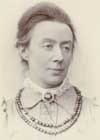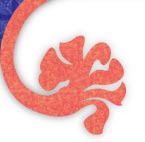A commentary by Elizabeth Cumming
Phoebe Anna Traquair's place in history is unique. She was the first important professional woman artist of modern Scotland.
To rank as such might be enough to ensure her fame, but Traquair was also a central figure within Scottish Arts and Crafts practice, working prolifically in such diverse fields as embroidery, enamelwork, leather book-cover tooling and, not least, manuscript illumination and mural decoration.
Passion for materials
Inspired by a wide range of arts and cultures, she was driven by a quest for ideas and a passion for materials. She considered that the arts should collectively express and celebrate the spiritual depth and wholeness of life. She ignored traditional boundaries of 'fine' and 'applied' art, and was therefore refused even associate membership of the Royal Scottish Academy in 1900. Only in 1920 was she eventually elected an Honorary Academician.
Traquair's early work

Born Phoebe Anna Moss, near Dublin, she was inspired from childhood by 'The Book of Kells'. Following marriage in 1873 to Scots palaeontologist Dr Ramsay Heatley Traquair (1840-1912), she moved with him to Edinburgh. She provided detailed illustrations for his research papers until his retirement in 1906 from the Museum of Science and Art (today the Royal Museum). Such detailed drawing of fossils prepared her for the closeness of manuscript work, but the latter gave new scope for the imagination.
Edinburgh's 'Sistine Chapel'
Traquair exhibited her crafts internationally from 1893 and painted the interiors of no fewer than four Edinburgh buildings between 1885 and 1901, including the chapels of the Royal Hospital for Sick Children (1885-1886 and 1896-1898) and the Song School of St Mary's Episcopal Cathedral (1888-1892). The best known is the vast former Catholic Apostolic Church (1893-1901) in East London Street which has been called 'Edinburgh's Sistine Chapel' and was decorated in parallel with her manuscripts of the 'Sonnets from the Portuguese' and 'The House of Life'. (See Further resources page for more.)
Traquair as illuminator
Traquair's reading of poetry and related work in manuscript illumination was initially inspired by her close friendship with John Miller Gray (1850-94), first curator of the Scottish National Portrait Gallery. Gray admired the poetry of Garth Wilkinson and Dante Gabriel Rossetti, encouraging Traquair to produce modern manuscripts of their work. In 1887 she wrote to the critic John Ruskin for advice, and received in return the loan of French manuscripts to copy and understand.
Major manuscripts
From 1890 Traquair leased dedicated studio space in the Dean Studio, a disused church (a gap site since the 1950s) next to Drumsheugh Swimming Baths in Lynedoch Place, where her major manuscripts, including 'Sonnets from the Portuguese' and 'The House of Life', were illuminated. Her first major multi-page manuscript was of Alfred Lord Tennyson's 'In Memoriam' (1890-1892) for Sir Henry Hardinge Cunynghame. It was immediately followed by 'Sonnets from the Portuguese'.
While working on her 'Sonnets', Traquair also illuminated Robert Browning's 'Saul' (1893-1894), William Morris's 'Defence of Guinevere' and 'The Song of Solomon' (both 1897). Her last great manuscripts were of Dante Gabriel Rossetti's 'The Blessed Damozel' (1897-1898), Sir Thomas Browne's 'Religio Medici', Rossetti's 'The House of Life' and Dante's 'La Vita Nuova' (1899-1902). Several of these manuscripts, including 'Sonnets from the Portuguese', were published on completion by William Hay of Edinburgh.
Enamel work
In the 1900s Traquair changed direction. She took up enamelling, to be set as jewellery and formal display pieces such as triptyches and caskets. From this time watercolour paintings for reproduction as commercial book illustrations replaced illumination.



